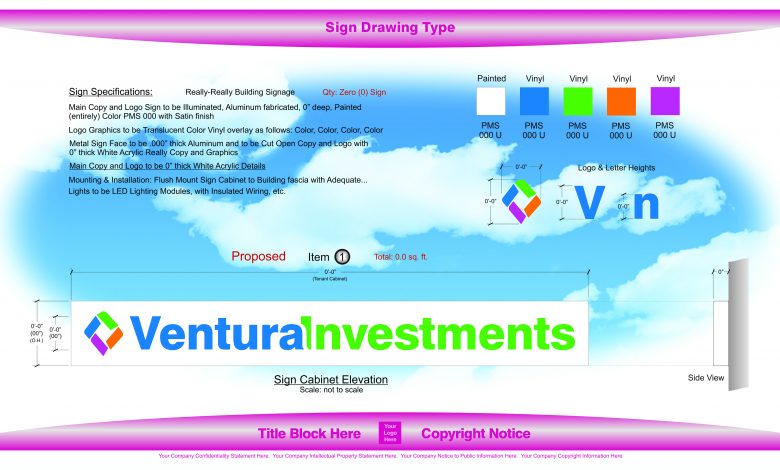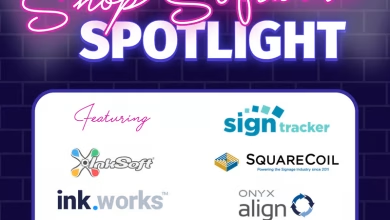“We can’t build this!” is the phrase I heard repeatedly for one year while working at a mid-sized commercial sign company in Los Angeles.
How is it possible that I was hired with a sign company without having the skills to design signs? How can a sign company afford to pay a graphic designer to create sign designs that can’t be built? This makes no sense. A sign company shouldn’t be paying for drawings with the likelihood that more revisions are coming.
Interestingly, the owner who hired me already had options in place. The owner outsourced certain jobs. Difficult sign projects, large and small, and other jobs that were technical in nature went to an experienced designer. Designs that involved architectural sign monuments and pylons went to a professional off-site sign designer. Sign projects that required design-to-build “shop” drawings were outsourced. Large, technically-oriented jobs went to someone who knew exactly how to create winning proposals. That’s right, a sign-design subcontractor. And she was very good. But eventually she moved out of state, got married, and is no longer in the business.
Have you ever had to hire a graphic designer who had no skills to design signs? Maybe, maybe not. But that doesn’t mean tomorrow you might have to. Professionally created sign designs and drawings keep a sign company moving forward. A sign company owner would do well to keep this idea at the forefront of their business model.
When I first started at a sign company in 2002, it took me every bit of one year to learn outdoor sign design, and no one taught me anything. The most important question for the sign business remains: What sign company can afford to have drawings created that can’t be built?
Today, business is non-stop, go, go, go. Having a back-up plan should be important, maybe even critical. Today’s customer needs to see drawings fast, which will include sign design along with a few options (so you can reduce a few steps in the sales process). So, drawings provide a business communication tool that will get you a meeting. It is then a sales person’s responsibility, not a design or a designer, to sell a project. If you’re a closer, with the right designer, it is possible to triple and quadruple your sales within a span of several years. I know, because I have seen it done with several sales people.
When I look back at my hiring experience, I realize that most sign companies have no choice but to hire a graphic designer with no knowledge of signage and create their own professional designer. A majority of the skilled sign designers already work for a sign company. Professional sign designers not working for a sign company often start their own business as subcontractors. I know many people who have gone this route.
A professional sign designer who works independently as a subcontractor may or may not have business acumen. However, it is vitally important to look for the one who does since they provide the best solutions to ensure your drawing headaches will go away.
Ever scour a sign forum online? Of course, you have. You can see which freelancers are hired. Freelance is usually an after-hours gig for someone who already has a full-time job. On the other hand, a subcontractor will work Monday through Friday, from sunup to sundown, and overtime (and the cost remains the same). A subcontractor will answer the phone and email back — if not immediately, they will get back to you quickly. The best part is, when you don’t send any sign projects to them, you’re not paying for anything.
While subcontractors and freelancers are good for spot work, by all means, keep your in-house designer. An in-house designer is mandatory for a brick and mortar sign company. An in-house designer is needed to set up production files, back up a computer and do a majority of the design and drawing work. Just be sure not to overload them with work because they can only do so much. Overloading an in-house designer has consequences with productivity and may spill over into creating other problems with your business.
For example, your sales team cannot get back to a customer fast enough if a designer is overloaded and takes too long with designs and drawings. How is a sales person supposed to close a sale without drawings where the competition gets to the customer first?
Also, a college degree does not necessarily make for a better designer. It may make for a better graphic designer, but may not translate well with other design trades. Simply put, a design degree is not a guaranteed indicator of whether someone will work out as a sign designer. It’s is a very difficult skillset to learn.
With high-speed internet today, subcontractors are a viable option that more sign companies are using, even if it is means outsourcing several projects a month. An experienced sign designer will provide more than sign design and sellable drawings; they will provide solutions. Sign designers who provide subcontracting work understand the importance of providing an exceptional service. So then, solutions for faster sign design and drawings do exist. And they could help your company get drawings turned around faster. A business secret some companies have discovered is having the perfect mix of in-house design, subcontract and freelance work.
Unfortunately, finding that perfect mix isn’t easy. For example, take a look at online sign forums with various freelancers who are hired by sign companies (almost on a regular basis). Some people rave about it. The problem is, one designer can only take on so many sign companies. Once critical mass has been reached, a designer must either turn away business or drawings will naturally take longer. Overloading a designer is not a good thing, at all, at any time.
Let’s face it, faster sign design and faster sign drawings are entirely possible, and for some companies, it has become the norm. Over time, some companies learn things others do not. This information is not broadcasted. It is a competitive advantage to have a designer or contract with a designer who can turn around drawings quickly.
Once you find a sign designer who is good and fast at providing design and drawing solutions for your sign company, you might have a leg up on all of your competition.
Landing the sale
So, how is your graphic designer with an outdoor sign design project? Fast? How about working on a custom project for a high-end client? Fast? What about creating professional drawings for a national company? Fast? And what will it take to reduce the amount of drawings that go out and never amount to a sale?
Based on casual conversations with many sign companies, the number of drawings that go by the wayside could be as high as 50 percent. One way to increase successful sales is to makes sure your design and revision process is as fast as possible so sales reps always have something to sell.
Can an in-house sign designer possibly do everything required for your company to win as many projects as possible? I often hear companies say their designers’ turnaround time is three to four days. A simple revision can take up to two days. The faster your shop can get back to a customer, the odds are greater you will win the work.
As a sign company owner or sales person, you should never have to pressure your designer to go faster. It should be a given because they should be aware of their importance to the process. You should never have to yell at your designer and stress yourself out. You should never have to say, “We can’t build this,” because more revisions mean more wasted time. And time is money.
The faster you get back to your customer, the greater chances you will win a sign bid. That’s why you are in business, right?
To learn more about this technical drawing process to speed up your art department, visit www.SignBusinessBooks.com. Ask for a free sample download of any eBook on the website.







